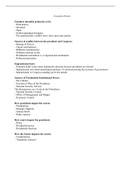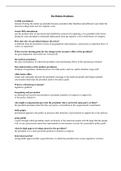Callig
On this page, you find all documents, package deals, and flashcards offered by seller callig.
- 5
- 0
- 0
Community
- Followers
- Following
5 items

Executive Power Class notes GOVT-320
This set of notes covers various aspects of the presidency, including the founders' intent for primaries, sources of conflict between the president and Congress, impeachment facts, sources of presidential institutional power, and the impact of presidents on the courts. It also explores various models of the presidency, including personal and psychological models, and the concept of emotional intelligence. The notes cover sources of expanded war power, including the president's ability to act u...
- Class notes
- • 3 pages •
This set of notes covers various aspects of the presidency, including the founders' intent for primaries, sources of conflict between the president and Congress, impeachment facts, sources of presidential institutional power, and the impact of presidents on the courts. It also explores various models of the presidency, including personal and psychological models, and the concept of emotional intelligence. The notes cover sources of expanded war power, including the president's ability to act u...

The Presidency final study guide ( GOVT-320)
The document titled "The Presidency final study guide" explores various topics related to presidential power, accountability, and responsibility, particularly in the modern era from FDR to the present. It covers a range of subjects, including checks on presidential power, party leadership, the judiciary's relationship with the president, different leadership styles, and strategies for ensuring accountability. The document also delves into specific examples, such as the Trump and Biden adminis...
- Class notes
- • 3 pages •
The document titled "The Presidency final study guide" explores various topics related to presidential power, accountability, and responsibility, particularly in the modern era from FDR to the present. It covers a range of subjects, including checks on presidential power, party leadership, the judiciary's relationship with the president, different leadership styles, and strategies for ensuring accountability. The document also delves into specific examples, such as the Trump and Biden adminis...

The President and the Judiciary Class notes GOVT-320
These notes discuss the relationship between the President and the Judiciary, covering topics such as the judicial appointment process, the powers of the judiciary, the legislative veto, executive privilege, and the two-presidencies thesis. The process for nominating and approving judges is detailed, highlighting the role of the executive office and the Senate. The powers of the judiciary are also explained, including their ability to declare laws unconstitutional and represent the rights of min...
- Class notes
- • 2 pages •
These notes discuss the relationship between the President and the Judiciary, covering topics such as the judicial appointment process, the powers of the judiciary, the legislative veto, executive privilege, and the two-presidencies thesis. The process for nominating and approving judges is detailed, highlighting the role of the executive office and the Senate. The powers of the judiciary are also explained, including their ability to declare laws unconstitutional and represent the rights of min...

The Presidency Notes week 2 GOVT-320
The document discusses the research of Barber, who categorized US Presidents based on their personalities as either "positive" or "negative" and "active" or "passive." The findings indicate that "positive active" Presidents, such as Theodore and Franklin Roosevelt, are more successful than their passive/negative counterparts. The document further explains the four categories of Presidents: active-positive, passive-positive, active-negative, and passive-negative. The author notes that w...
- Class notes
- • 2 pages •
The document discusses the research of Barber, who categorized US Presidents based on their personalities as either "positive" or "negative" and "active" or "passive." The findings indicate that "positive active" Presidents, such as Theodore and Franklin Roosevelt, are more successful than their passive/negative counterparts. The document further explains the four categories of Presidents: active-positive, passive-positive, active-negative, and passive-negative. The author notes that w...

The Modern Presidency Lecture notes GOVT-320
These notes cover various aspects of the modern presidency and its evolution over time, including the Twelfth and Twenty-fifth Amendments, the role of the vice president, the turning point of the Great Depression and World War II, the four main features of the modern presidency, and presidential tools for persuasion such as bargaining, the bully pulpit, and going public. The notes also discuss specific historical examples of presidential leadership styles and policies, including Franklin Rooseve...
- Class notes
- • 2 pages •
These notes cover various aspects of the modern presidency and its evolution over time, including the Twelfth and Twenty-fifth Amendments, the role of the vice president, the turning point of the Great Depression and World War II, the four main features of the modern presidency, and presidential tools for persuasion such as bargaining, the bully pulpit, and going public. The notes also discuss specific historical examples of presidential leadership styles and policies, including Franklin Rooseve...
